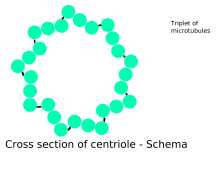Centriole



A centriSuper pie pageBold text |pages=83-85 }}</ref> found in most eukaryotic cells, though absent in higher plants and fungi.[1] The walls of each centriole are usually composed of nine triplets of microtubules. Deviations from this structure include Drosophila melanogaster embryos, with nine doublets, and Caenorhabditis elegans sperm cells and early embryos, with nine singlets.[2] [3] An associated pair of centrioles, arranged perpendicularly, constitutes the compound structure known as the centrosome.[4]
Function
Cell Division:
Centrioles are involved in the organization of the mitotic spindle and in the completion of cytokinesis.[5] Centrioles were historically thought to be required for the formation of a mitotic spindle in animal cells. However, more recent experiments have shown that cells whose centrioles have been removed via laser ablation can still undergo mitosis.[6] Additionally, mutant flies lacking centrioles can develop almost normally, although the adult flies lack flagella and cilia, a lack that underscores the requirement of centrioles for the formation of these organelles (see below).[7] Cells whose centrioles have been removed (either via laser ablation, or genetic manipulation) lack aster microtubules. These cells often fail to undergo proper asymetric cell division, as the aster microtubules help to position the spindle within the cell.
Cellular Organization:
Centrioles are an important part of centrosomes, which are involved in organizing microtubules in the cytoplasm.[8] [9]The position of the centriole determines the position of the nucleus and plays a crucial role in the spatial arrangement of cell organelles.
Cilliogenesis:
In organisms with flagella and cilia, the position of these organelles is determined by the mother centriole, which becomes the basal body. The inability of cells to use centrioles to make functional cilia and flagella has been linked to a number of genetic and developmental diseases. In particular, the inability of centrioles properly to migrate prior to ciliary assembly has recently been linked to Meckel-Gruber syndrome.
Animal Development:
Additionally, proper orientation of cilia via centriole positioning toward the posterior of embryonic node cells is critical for establishing left–right asymmetry during mammalian development.[8]
Structure of centrioles and mechanism of their duplication
Cells usually contain two complete centrioles. During cell replication, a new centriole grows from the side of each of the existing ones. The older of the two centrioles in a pair is called the mother centriole and the younger is called the daughter centriole. The two centrioles in the centrosome are connected to each other by proteins. The mother centriole has radiating appendages at the distal end of its long axis and is attached to the daughter centriole at the other proximal end. Each daughter cell formed after cell division will inherit one of these pairs (one older and one newer centriole). Duplication of centrioles starts at the time of the G1/S transition and ends before the onset of mitosis.[5]
References
- ^ L.M. Quarmby & J.D.K. Parker (2005). "Cilia and the cell cycle?". J. Cell Biol. 169 (5): 707–710. doi:10.1083/jcb.200503053.
{{cite journal}}: Unknown parameter|month=ignored (help) - ^ Marie Delattre and Pierre Gönczy, The arithmetic of centrosome biogenesis, Journal of Cell Science 117, 1619-1630 (2004)
- ^ SAS-6 defines a protein family required for centrosome duplication in C. elegans and in human cells, Nature Cell Biology 7, 115 - 125 (2005)
- ^ Cite error: The named reference
eddewas invoked but never defined (see the help page). - ^ a b Jeffrey L. Salisbury, Kelly M. Suino, Robert Busby, Margaret Springett; Centrin-2 Is Required for Centriole Duplication in Mammalian Cells; Current Biology, Volume 12, Issue 15, 6 August 2002, Pages 1287-1292; doi:10.1016/S0960-9822(02)01019-9
- ^ La Terra S, English CN, Hergert P, McEwen BF, Sluder G, Khodjakov A.; The de novo centriole assembly pathway in HeLa cells: cell cycle progression and centriole assembly/maturation.; Journal of Cell Biology, Volume 168, Issue 5, 28 Feb 2005, Pages 713-22
- ^ Basto R, Lau J, Vinogradova T, Gardiol A, Woods CG, Khodjakov A, Raff JW.; Flies without centrioles; Cell, Volume 125, Issue 7, 30 June 2006, Pages 1375-86
- ^ a b Jessica L. Feldman, Stefan Geimer, Wallace F. Marshall; The Mother Centriole Plays an Instructive Role in Defining Cell Geometry; PLoS Biol 5(6): e149 doi:10.1371/journal.pbio.0050149 (Creative Commons Attribution License)
- ^ Beisson, J. and Wright M. (2003). Basal body/centriole assembly and continuity. Current Opinion in Cell Biology 15, 96-104.
